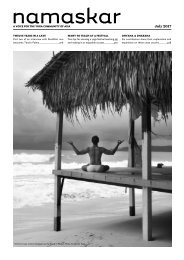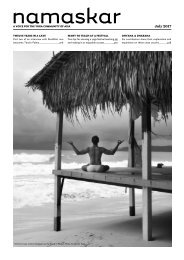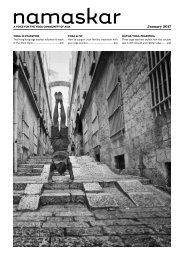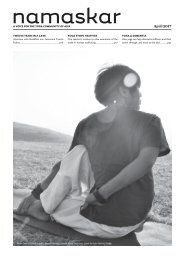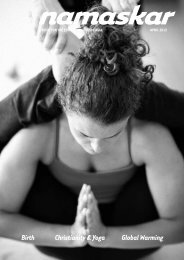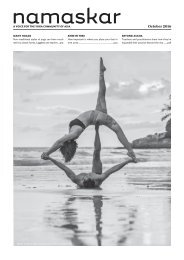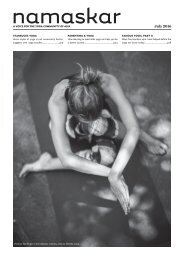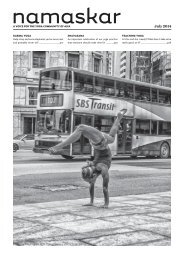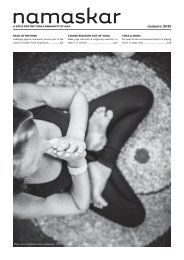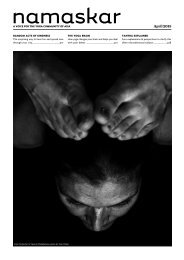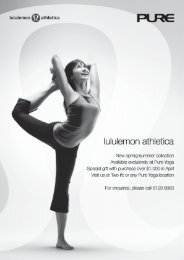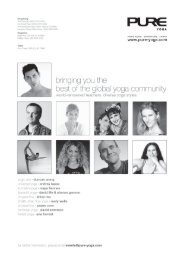Namaskar - Oct 09
You also want an ePaper? Increase the reach of your titles
YUMPU automatically turns print PDFs into web optimized ePapers that Google loves.
Anatomy<br />
Elbows and Yoga<br />
Valerie Wilson Trower<br />
The elbow may seem a strange part of<br />
the body to write about in<br />
conjunction with yoga however, after<br />
backs, knees, shoulders, and wrists, this<br />
joint commonly causes pain in a yoga<br />
practice. The purpose of this brief article is<br />
to introduce this joint and five common<br />
conditions which can arise.<br />
ELBOW ANATOMY<br />
The elbow is the joint where the upper arm<br />
bone (humerus) and the two lower arm<br />
bones (ulna and radius) meet. Elbows move<br />
in two dimensions: bend and straighten,<br />
and turning the forearm palm-up or palmdown,<br />
where the radius appears to cross the<br />
ulna.<br />
The shape of the elbow is gender sensitive:<br />
when the arm is extended, as it is usually is<br />
down the side of the torso, the forearm<br />
does not form a straight line with the upper<br />
arm. The angle formed is called the ‘carrying<br />
angle’ and is greater in women than in men<br />
because women generally have wider hips.<br />
Their elbows need to bend in order to<br />
accommodate their hip width.<br />
1. TENDONITIS<br />
Tendonitis is an inflammatory condition of<br />
the tendons, which connect muscles to<br />
bone. It is a common overuse injury,<br />
especially in people in their 40s and 50s.<br />
Tendonitis at the outside of the elbow<br />
(Tennis elbow), is caused by excessive<br />
gripping, lifting, and extension movements<br />
of the wrist when the elbow is straightened<br />
– as in a backhand tennis swing. Yoga is<br />
unlikely to cause this because fingers are<br />
usually spread when the elbow is straight –<br />
in Up and Down Dog, for example.<br />
Tendonitis at the inside of the elbow (also<br />
known as Golfer’s elbow) is caused by<br />
excessive gripping of the thumb and<br />
fingers, clenching the fist while the palm is<br />
facing up, or stressing the elbow whilst it is<br />
bent outwards in the carrying angle. This<br />
occurs in Chaturanga, Up Dog, and the<br />
Cobra when the hands are shoulder-width<br />
apart but the elbows are tucked in towards<br />
the mid-line of the body. People with<br />
narrow ribcages and waists experience this<br />
more because their elbow is tucked further<br />
inwards relative to their hands.<br />
Many people, who have never played tennis<br />
or golf, suffer from one of these problems.<br />
Treatment apart from rest, is not easy. It<br />
generally consists of anti-inflammatory<br />
medication, ice, stretching and strengthening<br />
exercises, massage, ultrasound, acupuncture,<br />
homoeopathy, or cortisone injections.<br />
2. POSTERIOR IMPINGEMENT<br />
Another common elbow injury is Posterior<br />
Impingement is and is felt at the back of<br />
the elbow when the elbow is straight. It is<br />
caused by compression of the elbow bones<br />
when they over-straighten or hyper-extend.<br />
This occurs when students lock their<br />
elbows, rather than use their muscles to<br />
support their weight. Incorrect practice of<br />
Vashishthasana (straight arm stretch pose),<br />
Up Dog, and Utplutihi (Tolasana, or Scale<br />
pose), may cause this. In Up Dog and<br />
Utpluithi, practice pushing hands in to the<br />
mat and supporting your weight on your<br />
muscles, try not to hang off your shoulders.<br />
Treatment includes anti-inflammatory<br />
practices as for tendonitis, and<br />
strengthening the elbow to reduce the<br />
weight on the joints.<br />
3. ULNAR NERVE ENTRAPMENT<br />
Ulnar Nerve Entrapment is a common<br />
result of the nerve becoming pinched or<br />
trapped. This can be caused by sleeping on<br />
one side, with one or both elbows bent,<br />
causing numbness in the little and ring<br />
fingers, which can be helped by raising the<br />
arm. This is a problem for many people and<br />
is not related to yoga practice.<br />
4. CERVIAL SPONDYLOSIS<br />
Arm pain can also be caused by problems<br />
with the cervical spine: cervical spondylosis<br />
will cause tenderness on the side of the neck<br />
beside the disk affected - this can be<br />
confirmed by an X-ray. Treatment means<br />
avoiding poses which cause pain for two to<br />
six months whilst it heals, and practising<br />
with care afterwards. These can include<br />
headstands, chakrasana (the backwards<br />
somersault), and any pose in which the<br />
weight is taken on the neck and shoulders.<br />
5. REPETITIVE STRAIN INJURY<br />
Lastly, Repetitive Strain Injury (R.S.I.) is a<br />
long-term psycho-social problem, which is<br />
unlikely to affect yoga students.<br />
Thanks to Virginia Brooks for her help in<br />
compiling this article.<br />
SMALLER CARRYING ANGLE AT ELBOWS FOR THOSE<br />
WITH NARROWER HIPS<br />
LARGER CARRYING ANGLE AT ELBOWS TO<br />
ACCOMMODATE WIDER HIPS<br />
Dr. V holds a docterate in<br />
Historical and Critical<br />
Studies, from The London<br />
College of Fashion, The<br />
University of the Arts,<br />
London. She practices<br />
Ashtanga yoga, Mysore<br />
style and leads Hatha yoga<br />
stretches for the Siddha Meditation Path.<br />
27



